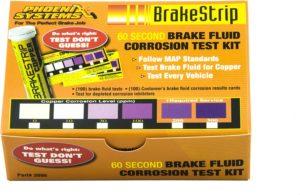Brake fluid is a type of hydraulic fluid that is used in the brake systems of vehicles. It is essential to the functioning of the brake system as it transfers the force of the brake pedal to the brake pads, resulting in the vehicle coming to a stop. Brake fluid is a specially formulated liquid that is designed to work at high temperatures and under high pressure. It is typically made up of glycol ethers or silicone-based fluids, and it comes in various grades depending on the type of brake system.
Brake fluid is a crucial component of a vehicle’s safety system, and as such, its maintenance is of utmost importance. Over time, brake fluid can become contaminated with moisture, which can lead to corrosion within the brake system. This can compromise the braking performance of the vehicle and lead to safety issues. Regular maintenance of the brake system, including testing and changing the brake fluid, can help to ensure that the brakes are working correctly and reliably.
Brake fluid test strips are a simple and effective way to test the condition of the brake fluid in a vehicle. These test strips are coated with a reactive material that changes color depending on the level of contamination in the brake fluid. By using a brake fluid test strip, a vehicle owner or mechanic can quickly determine if the brake fluid needs to be changed or if the system requires further maintenance. Brake fluid test strips are easy to use and provide a quick and cost-effective solution to maintaining the safety of a vehicle’s brake system.
Contents
What are Brake Fluid Test Strips
Brake fluid test strips are a diagnostic tool used to determine the quality and safety of the brake fluid in a vehicle. They are small pieces of paper or plastic that are coated with a reactive material that changes color in the presence of certain contaminants. The test strips are designed to be easy to use and provide a quick and accurate assessment of the condition of the brake fluid.
Brake fluid test strips are used to measure the level of contaminants in the brake fluid of a vehicle. These contaminants can include water, copper, and other metals, which can degrade the performance of the brake fluid over time. By using a brake fluid test strip, mechanics and vehicle owners can quickly and easily identify when it’s time to replace the brake fluid to maintain the safety and performance of the vehicle’s brake system.
There are several different types of brake fluid test strips available on the market. The most common type is the litmus paper test strip, which changes color in the presence of contaminants. There are also electronic test strips that can measure the conductivity of the brake fluid to determine its quality. Additionally, some test strips are designed to work with specific types of brake fluid, such as DOT 3, DOT 4, or DOT 5 brake fluid.
Brake fluid test strips work by reacting to the presence of contaminants in the brake fluid. When a test strip is dipped into the brake fluid, the reactive material on the strip will change color based on the level of contamination in the brake fluid. For example, if the brake fluid is contaminated with water, the test strip may turn blue, indicating that the brake fluid needs to be changed. By using a brake fluid test strip, mechanics and vehicle owners can quickly and easily assess the condition of the brake fluid and take appropriate action to maintain the safety and performance of the vehicle’s brake system.
Signs of bad brake fluid
There are several signs that may indicate that the brake fluid in a vehicle is bad and needs to be replaced. These signs include a spongy or soft brake pedal, a longer stopping distance, a burning smell when applying the brakes, and a warning light on the dashboard. These signs may be caused by a buildup of moisture, which can lead to corrosion within the brake system and affect the performance of the brake fluid. Regular testing and maintenance of the brake fluid can help prevent these issues and ensure that the brakes are functioning correctly.
Maintaining the proper level of brake fluid in a vehicle is critical to the safety and performance of the brake system. Low brake fluid levels can cause air to enter the brake lines, leading to a spongy brake pedal and reduced stopping power. Conversely, overfilling the brake fluid reservoir can cause the fluid to foam, which can also affect the performance of the brakes. Regular maintenance and testing of the brake fluid can help to ensure that the brake system is functioning correctly and reliably.
Failing to test and maintain the brake fluid in a vehicle can lead to several risks and safety issues. Contaminated brake fluid can corrode the brake lines and components, leading to a loss of brake pressure and increased stopping distance. This can cause accidents and put the driver and passengers at risk. Additionally, low brake fluid levels can cause the brake pads to wear down quickly, which can increase the risk of brake failure. Regular testing and maintenance of the brake fluid can help to prevent these issues and ensure the safety and reliability of the vehicle’s brake system.
How to Use Brake Fluid Test Strips
Step-by-step guide on how to use brake fluid test strips:
- Locate the brake fluid reservoir and remove the cap.
- Dip the test strip into the brake fluid for a few seconds.
- Remove the test strip from the fluid and wait for the color to develop.
- Compare the color of the test strip to the color chart provided with the test strips to determine the level of contamination in the brake fluid.
- If the test strip indicates that the brake fluid is contaminated, replace the fluid according to the manufacturer’s recommendations.
Common mistakes to avoid while using brake fluid test strips:
- Not cleaning the reservoir before testing. It is important to clean the reservoir and cap before testing to ensure accurate results.
- Not waiting long enough for the test strip to develop. It is important to wait for the recommended amount of time for the color to develop before comparing it to the color chart.
- Using an expired or damaged test strip. Always check the expiration date and condition of the test strips before use.
- Not using the correct type of test strip for the brake fluid in the vehicle. It is important to use the appropriate test strip for the specific type of brake fluid used in the vehicle to ensure accurate results.
- Not following the manufacturer’s instructions. Always follow the instructions provided with the test strips for accurate and reliable results.
Choosing the Right Brake Fluid Test Strips
Factors to consider while selecting brake fluid test strips:
- Compatibility: Ensure that the test strips are compatible with the type of brake fluid in your vehicle. Different types of brake fluid require different types of test strips.
- Sensitivity: Choose test strips that are sensitive enough to detect low levels of contamination in the brake fluid.
- Accuracy: Look for test strips that are known for their accuracy and reliability.
- Ease of use: Choose test strips that are easy to use and interpret.
- Brand reputation: Consider the reputation of the brand and look for reviews and feedback from other users.
There are several types of brake fluid, including DOT 3, DOT 4, and DOT 5.1. Each type of brake fluid requires a specific type of test strip for accurate testing. For example, DOT 3 and DOT 4 brake fluid test strips typically use a glycol-based formula, while DOT 5.1 brake fluid test strips use a silicone-based formula.
There are several brands of brake fluid test strips available in the market, including Phoenix Systems, ABN, and Johnsen’s. It is recommended to choose a reputable brand with positive reviews and feedback from other users. Additionally, it may be helpful to consult with a mechanic or automotive professional for their recommendations on the best brake fluid test strips for your specific vehicle.
CHECK OUT ALL OF THE BRAKE FLUID TEST STRIPS ON AMAZON
Conclusion
Regular testing of brake fluid is an essential aspect of vehicle maintenance that should not be overlooked. Brake fluid can become contaminated over time, leading to decreased performance and safety risks. Regular testing and maintenance can help prevent brake failure and ensure that the brake system is functioning correctly. Using brake fluid test strips is a quick and easy way to test the condition of the brake fluid in a vehicle.
Brake fluid test strips are a simple and effective tool for testing the condition of brake fluid in a vehicle. Regular testing and maintenance can help prevent safety issues and prolong the life of the brake system. It is important to follow the manufacturer’s instructions and use the appropriate test strips for the specific type of brake fluid in the vehicle.
As technology continues to advance, new methods for testing brake fluid may emerge. Some manufacturers are already developing digital brake fluid testers that can provide more precise and accurate readings. Additionally, there may be new methods for testing brake fluid that are more environmentally friendly and cost-effective. As the automotive industry continues to evolve, it is likely that the methods for testing brake fluid will also continue to advance.

